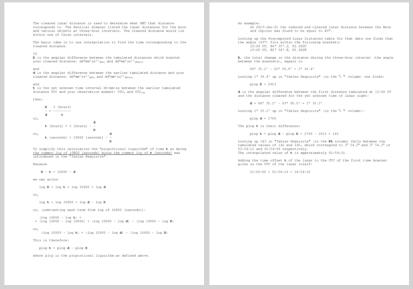
NavList:
A Community Devoted to the Preservation and Practice of Celestial Navigation and Other Methods of Traditional Wayfinding
From: Tony Oz
Date: 2016 Sep 1, 11:26 -0700
Thanks, Robin.
The problem is that the raw lunar distances in the Almanac have been rounded to the nearest 0.1' so when you subtract two of them your answer could be off from the true value by something approaching 0.1'. I would expect that the proportional logarithms given in the Almanac are produced by first subtracting the lunar distances carrying all the figures along and then computing the proportional logarithm. It is therefore more accurate to use that value in the calculation,
I hope the calculations and roundings were done in the proper order.
This is how I understand the usage of the prop.log tables (used this and this for compilation):
The cleared lunar distance is used to determine what GMT that distance corresponds to. The Nautical Almanac listed the lunar distances for the moon and various objects at three-hour intervals. The cleared distance would lie within one of those intervals.
The basic idea is to use interpolation to find the time corresponding to the cleared distance.
If
D is the angular difference between the tabulated distances which bracket your cleared distance: dd°mm’ss’’UTCi and dd°mm’ss’’UTCi+3
and
d is the angular difference between the earlier tabulated distance and your cleared distance: dd°mm’ss’’UTCi and dd°mm’ss’’UTCi+t
and
t is the yet unknown time interval hh:mm:ss between the earlier tabulated distance UTC and your observation moment: UTCi and UTCi+t
then:
D 3 [hours]
- = ---------
d t
or,
d
t [hours] = 3 [hours] ∙ -
D
or, d
t [seconds] = 10800 [seconds] ∙ -
D
To simplify this calculation the "proportional logarithm" of time t as being "the common log of 10800 [seconds] minus the common log of t [seconds]" was introduced in the "Tables Requisite".
Because
D ∙ t = 10800 ∙ d
we can write:
log D + log t = log 10800 + log d
or,
log t = log 10800 + log d - log D
or, (subtracting each term from log of 10800 [seconds]):
(log 10800 - log t) = (log 10800 - log 10800) + (log 10800 - log d) - (log 10800 - log D)
or,
(log 10800 - log t) = (log 10800 - log d) - (log 10800 - log D)
This is therefore:
plog t = plog d - plog D
where plog is the proportional logarithm as defined above.
A usage example:
On 2015-Jan-01 the reduced and cleared lunar distance between the Moon and Jupiter was found to be equal to 83°.
Looking up the Precomputed Lunar Distances table for that date one finds that the angle (83°) fits within the following brackets:
- 12:00 UT, 84° 35'.2, PL 2620
- 15:00 UT, 82° 56'.8, PL 2628
D, the total change in the distance during the three-hour interval (the angle between the brackets), equals to
84° 35.2' - 82° 56.8' = 1° 38.4'
Looking 1° 38.4' up in "Tables Requisite" (in the h° m’ column) one finds:
plog D = 2623
d is the angular difference between the first distance tabulated at 12:00 UT and the distance cleared for the yet unknown time of lunar sight:
d = 84° 35.2' - 83° 00.0' = 1° 35.2'
Looking 1° 35.2' up in "Tables Requisite" (in the h° m’ column):
plog d = 2766
The plog t is their difference:
plog t = plog d - plog D = 2766 – 2623 = 143
Looking up 143 in "Tables Requisite" (in the PL column) falls between the tabulated values of 142 and 145, which correspond to 2h 54.2m and 2h 54.1m or 02:54:12 and 02:54:06 respectively.
The interpolated value of t is approximately 02:54:10.
Adding the time offset t of the lunar to the UTC of the first time bracket gives us the UTC of the lunar itself:
12:00:00 + 02:54:10 = 14:54:10
English is not my native, so everyone is welcome to comment and correct the text.
Thank you in advance.
Regards,
Tony







